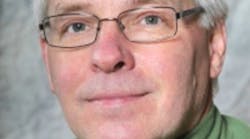Santa Clara, CA. Innovation—everybody talks about it and some people do something about it. How to innovate was the theme of a Tuesday DesignCon keynote address titled “The Key Building Blocks in Surviving/Thriving in the Era of Exponential Technologies,” presented by Al Eisaian, CEO of IntelinAir Inc., a company that provides farmers with “actionable intelligence from aerial information.”
Innovation, Eisaian said, can have impacts on the home and business as well as on a much bigger scale: all of humanity.
Eisaian began as a test engineer and learned how important it is that things work the way they are meant to work and advertised to work. That can present difficulties because, he said, we face a whirlwind of information and can miss a lot of details. So much information is coming at us that we feel like we are falling behind.
He noted that capital might no longer be the foundation of new and connected economy, explaining that much of what we work on becomes available ubiquitously. “I think that’s a good thing,” he said, but added that large companies are struggling to win in this new world of networked sensors and intelligent robotics
Eisaian posited a “5C” framework that he’s been following to create companies.
The first C stands for “caring.” Given technology and capital, why should a particular project exist? Because you care deeply about it, he said. That’s the first foundational level of any worthwhile project. “Every project or company has started in my heart—not my head,” he said.
Next comes “commitment.” You must burn with passion to bring your project to reality. He said he embarked on a 40-year commitment to poverty reduction, adding that he’s on year 11 and has increased the time to 60 years. “Ultimately, bettering humanity requires that level of commitment,” he said. Tinkering in high school doesn’t create an engineer, he said. That requires commitment to study.
The third C stands for “competency,” requiring focus and knowing what you are talking about. He said he has had several failures as well as successes but has a core belief that for almost everything in life and with right focus, you can develop the competency to move forward.
Next comes “creativity.” You have to add to the knowledge that’s out there, he said. And you need to share and take risks in your personal or professional life. And if you have an idea that’s not letting you sleep at night, you need to stick with it.
The fifth and final C stands for “community.” You need to encourage a close-knit community, he said, and convince others that what you’re working on is worthwhile. You must listen, invite, inspire, and recruit. The days of the lonely engineer in a corner inventing things are over, he said, with the majority of projects based on collaboration.
Eisaian said that innovation is a big loaded word that everyone uses, but, he asked, “How do you do it?” Start with ideas and engage them with playfulness, he said. Provide yourself with reminders, and make use of visuals and sharing. Ideas at core of innovation, he said, adding that your organization needs an idea-generation culture
“We actively set aside time to brainstorm in a way that’s playful and lets people express what they want to work on,” he said. “Don’t wait for leaders to introduce [an idea]. I never waited for somebody to give me permission. Inside of companies, trust me, I love people who are like the squeaky wheels. They are the lifeblood of companies.”
All brains should be working and all hands should be working, not one brain and many hands, he said. It’s a telltale sign of what’s not working when an organization hires one man or woman and says, “You are head of innovation.” That idea is bankrupt, he said.
Eisaian emphasized the importance of scheduling reminders to spend time generating ideas and of the importance of visuals, such as the ones you might see in conference poster sessions. As for sharing, he said, “You don’t know a subject unless you can teach it. “
He also noted that decluttering your mind speeds you up. Minimize email chatter, freeing those cycles for more creative productive work.
Wrapping up his presentation, he said, “There really are no failures—just lessons.” That realization frees people to become risk takers, the ones who are winning.
“Passion is key, he said. “Think with your heart.”
In closing, he recommended several resources, including Abundance: The Future Is Better Than You Think, by Peter H. Diamandis and Steven Kotler, and their follow-up Bold, as well as Finding Your Element, by Sir Ken Robinson.
The keynote session included a slideshow in memory of Steve Weir, an engineering consultant who was a longtime active participant in DesignCon.

